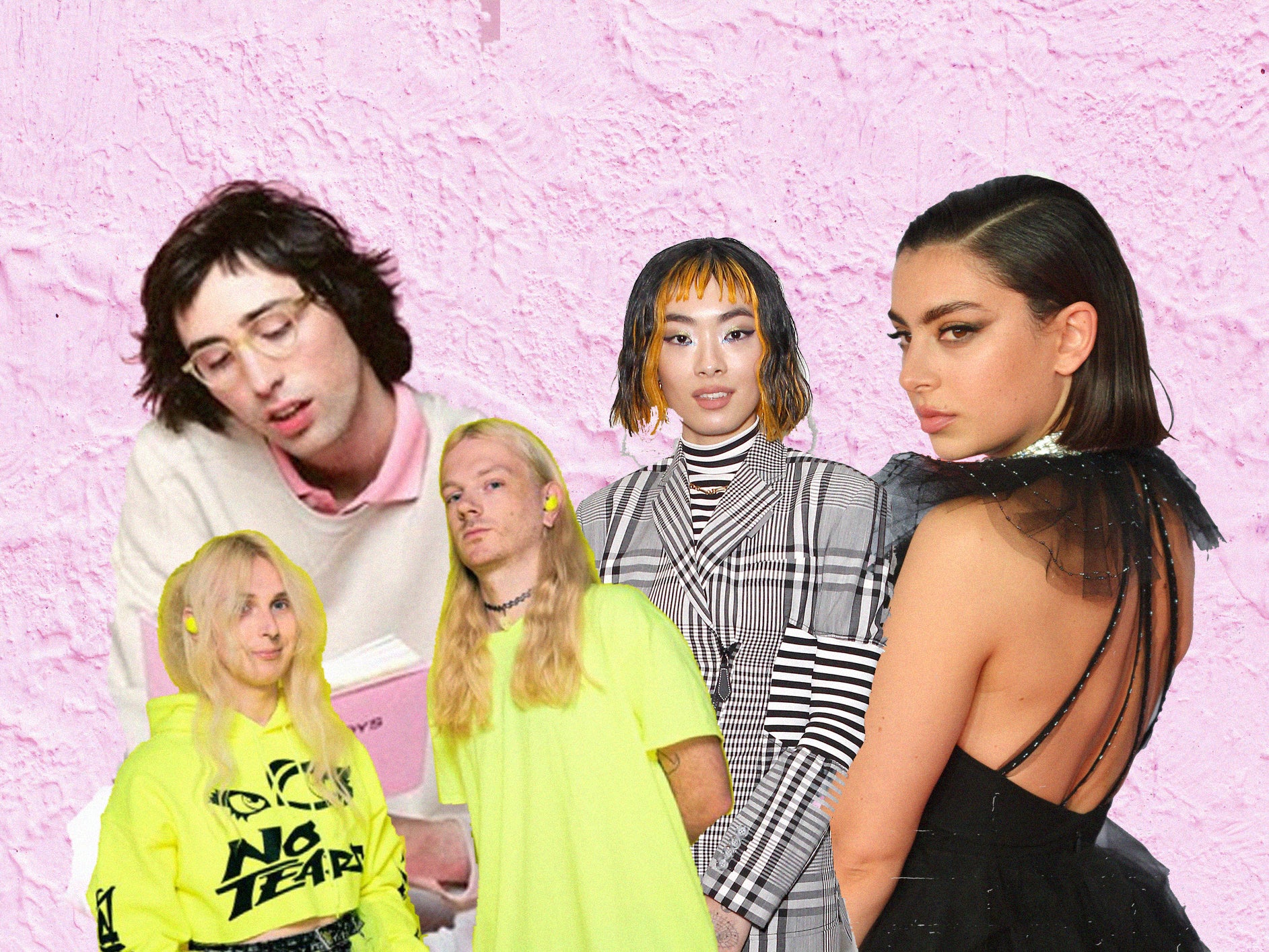Hyperpop or overhyped? The rise of 2020’s most maximal sound
From Charli XCX to Rina Sawayama, the sugary, synthy and surreal style known as hyperpop has become one of the most talked-about music trends this year. But it’s far bigger than genre, says Will Pritchard

Your support helps us to tell the story
From reproductive rights to climate change to Big Tech, The Independent is on the ground when the story is developing. Whether it's investigating the financials of Elon Musk's pro-Trump PAC or producing our latest documentary, 'The A Word', which shines a light on the American women fighting for reproductive rights, we know how important it is to parse out the facts from the messaging.
At such a critical moment in US history, we need reporters on the ground. Your donation allows us to keep sending journalists to speak to both sides of the story.
The Independent is trusted by Americans across the entire political spectrum. And unlike many other quality news outlets, we choose not to lock Americans out of our reporting and analysis with paywalls. We believe quality journalism should be available to everyone, paid for by those who can afford it.
Your support makes all the difference.Earlier this summer, the British pop star Charli XCX put out a simple tweet: “what is hyperpop?” It’s a term that has been liberally thrown around to describe many a pop musician this year, from Rina Sawayama to Dorian Electra and even certain tracks by the rapper Rico Nasty. XCX quickly followed her post with one adding, “I do not identify with music genres”. But her query prompted many people to ask the same thing: what exactly is hyperpop? And how has it become the most hyped sound of 2020?
Hyperpop is a self-referential, humorous and excessive brand of pop music that is apparently everywhere at the moment and proliferating lightning-fast in the era of TikTok. It’s a sound enthralled with taut, squeally synth melodies and Auto-Tuned earworm hooks, but also surrealism, nostalgia for the apparently bygone internet age of the Noughties, and distortion, lots of it. Songs tend to be short and snappy – many of them styled in lowercase – but manage to pack in a bewildering array of stylistic elements, everything from bubblegum pop and Eurohouse, to hip-hop, trance, J- and K-pop, emo and even nu-metal.
The acts associated with the term, whether they want to be or not, tend to straddle the avant-garde and the pop charts simultaneously, helped along by TikTok trends and dedicated Spotify playlists. Their albums have dominated end-of-year lists: Charli XCX’s Mercury-nominated how i’m feeling now, Rina Sawayama’s self-titled debut, and Apple by AG Cook, a long-time collaborator with XCX, and considered the “godfather” of the genre with his label PC Music.
But to group these artists under even the loosest of collective terms is to do a disservice to the enormous range at play under the hyperpop umbrella. You have the futuristic pop chops of XCX and Cook alongside the more esoteric underground electronics of artists such as Arca and – a former PC Music affiliate – SOPHIE, which in turn sit next to strands indebted to early Noughties nu-metal (Sawayama’s a good starting point here), and a growing number of acts channelling various internet-born, hip-hop-adjacent genres like cloud rap and emo rap (try Sega Bodega or glaive).
Certain characteristics crop up across the broad spread: vocals tend to be heavily processed; metallic, pitched percussion sounds add melodic counterpoints; synths are pitched up and down with gleeful (yet precise) abandon. Choruses are catchier than a common cold. Shiny, cutesy aesthetics are often juxtaposed with angst-ridden lyrics: in the video for “pissed”, 15-year-old rapper glaive frolics in the woods dressed as a racoon. He playfully raids the bins of a log cabin while seething with anger and suicidal thoughts (“I'm so pissed, I'm angry as f***/ I wanna kill myself, but you’re calling my bluff”) over a chirpy chiptune beat. It's inviting and unsettling in equal measure.

Then there’s musical duo 100 gecs, whose rapid rise has been a focal point for hyperpop pontificating. Considered the new overlords of the genre, the pair make full-blown aural assaults that take hyperpop to its most extreme, and extremely catchy, conclusions: stadium-sized trap beats processed and distorted to near-destruction, overwrought emo vocals and cascades of ravey arpeggios. Their streaming numbers are in the hundreds of millions. Obsessive fans are petitioning to have the unassuming pine tree featured on the cover of 100 gecs’ debut album, 1000 gecs, listed as the eighth wonder of the world.
They are, it turns out, canny pop manipulators. In an interview with the music website Pitchfork this October, one half of 100 gecs, Dylan Brady, said that, if he had an intern, he would get them to catalogue ever song in the Billboard Hot 100 and categorise them by factors such as “instrument, key, tempo, BPM” as well as “pitch correction, speed of Auto-Tune” and outliers such as “songs that have no drums that reached number one”. The idea presumably being that, equipped with this exhaustive list of metrics, he and bandmate Laura Les would be able to cram all of the best-performing factors together into a single, ultimate hyperpop song. 100 gecs don’t have an intern, but this is still an apt way of framing this sometimes overwhelming, multi-sensory music, which attempts to be many things at the same time.
For all its hype, to some, the ground covered by hyperpop won’t seem all that new. It’s possible to see it as an expression not just of the genres it borrows from, but of the scene that evolved around AG Cook’s PC Music label (an early home to SOPHIE and Charli XCX, among others) in the UK in the early 2010s. Even then, the sounds PC Music were putting out had contemporaries in the likes of Rustie and Hudson Mohawke (who also worked with Kanye West around the same time as Arca) and whose fluoro, trance-edged smooshes of dance and hip-hop are reminiscent of a lot of hyperpop today.
If you wanted to go further back, then bands like Test Icicles (Blood Orange’s early band) or other outliers of the much-maligned “nu rave” scene in London might fit a similar bill. There’s not much rhythmic innovation to speak of. The more distinct introduction of nu-metal into the mix could be considered a natural evolution for a genre whose artists have a tendency to rehabilitate styles of music that have long since gone out of fashion, constantly poking at what is or isn’t “cool” or artful.
Enjoy unlimited access to 100 million ad-free songs and podcasts with Amazon Music
Sign up now for a 4 month free trial (3 months for non-Prime members)
Enjoy unlimited access to 100 million ad-free songs and podcasts with Amazon Music
Sign up now for a 4 month free trial (3 months for non-Prime members)
However, it’s impossible to fully understand hyperpop without considering its Extremely Online context and its significance among LGBTQ+ youth. Many of the genre’s key players are trans; queerness and hyperpop have been called “inseparable”. This has surfaced in specific ways in the music too, as vocal modulation has allowed artists to explore the fluidity of gender with their voices. Elsewhere, the genre’s curiosity and boundless appetite twin with the way queer communities have formed on blank-slate social sites like Tumblr. In-jokes, references, and niche disputes run through the songs and online discussions buoy the scene. One of hyperpop’s surprise hits, “bad idea” by osquinn, stemmed directly from an argument the 15-year-old had been having on Twitter.
Hundreds of other acts contribute to this bubbling ecosystem that exists on chat apps and social media sites, their artist names indecipherable from the familiar coding of online usernames: cookii; Forevrboy; blackwinterwells. The lowercase song titles are as if typed straight from a messaging app. Many of hyperpop’s most popular new artists are still teenagers or edging into their twenties.
Hyperpop isn’t just found and shared on the internet: it’s shaped by it too. The music itself has all the hallmarks of meme culture: endless remixes and reinterpretation of existing sounds and signifiers, with humour and kitsch masking more serious or sincere emotions. This figures quite literally in some cases; the distortion and pitch-bent synths on tracks like 100 gecs’s “toothless” recall how French electro producer Breakbot’s 2011 track “Baby I’m Yours” was manipulated and used in the never-ending escalation of Saddam Hussein capture memes.
Distortion in particular is used to emphasise technology’s imperfections, a trope also reflected in hyperpop’s rose-tinted nostalgia for the early days of Web 2.0, when people first began creating their own spaces on the internet. Visuals are littered with cheap-looking 3D renders. PC Music got its name from the way home computers had closed the gap between bedroom and professional studio; hyperpop takes that to its mobile-apped extreme. It’s perhaps no coincidence that both hyperpop and TikTok have exploded into wider consciousness in a year that most of us have been alone in our rooms, online.
The potential of hyperpop has not been lost on Spotify, whose dedicated “hyperpop” playlist currently boasts just shy of 150,000 followers. This is not a huge number by Spotify’s standards, but it’s significant that a sonically and creatively disparate scene is being centralised in this way (especially at a time when the amount that the streaming giant pays artists for their music is coming under fire). Spotify calls it a “community-based playlist” and regularly invites leading artists in the scene to curate songs on the list.
But even hyperpop's all-encompassing ethos/one-size-fits-all brand has its limitations. When the “godfather” of hyperpop AG Cook added songs by the likes of Nicki Minaj, J Dilla, and Kate Bush to the playlist, he was met with significant backlash from fans and artists. They felt these established artists with no clear connection to the scene were squeezing out smaller, more relevant acts – ones who were, osquinn told The New York Times recently, “literally living off that Spotify check”. While cash is rarely the best measure of a scene’s efficacy or appeal, this small event is a reminder of the danger communities face when they’re not in control of the internet platforms they depend on. Tumblr’s disastrous “adult content” ban in 2018 left many of its staunch LGBTQ+ communities virtually homeless. In 2019, a “server error” erased more than 50 million songs from Myspace’s archives.
Whether you believe it’s breaking new musical ground or not, hyperpop is clearly something that holds huge importance to its mostly young, extremely passionate audience. The overwhelming response to that Charli XCX tweet – “what is hyperpop?” – was fans simply answering “you”. But the obvious truth is, it’s much bigger than just one person. The way this community navigates the ethereal nature of internet fandom will be its success or its undoing. PC Music’s key protagonists, XCX included, have progressed in large part because of the control they retained over their own direction. The young creatives in hyperpop’s engine room would do well to keep on doing the same – or else risk bursting in a shiny technicolour bubble of hype.



Join our commenting forum
Join thought-provoking conversations, follow other Independent readers and see their replies
Comments